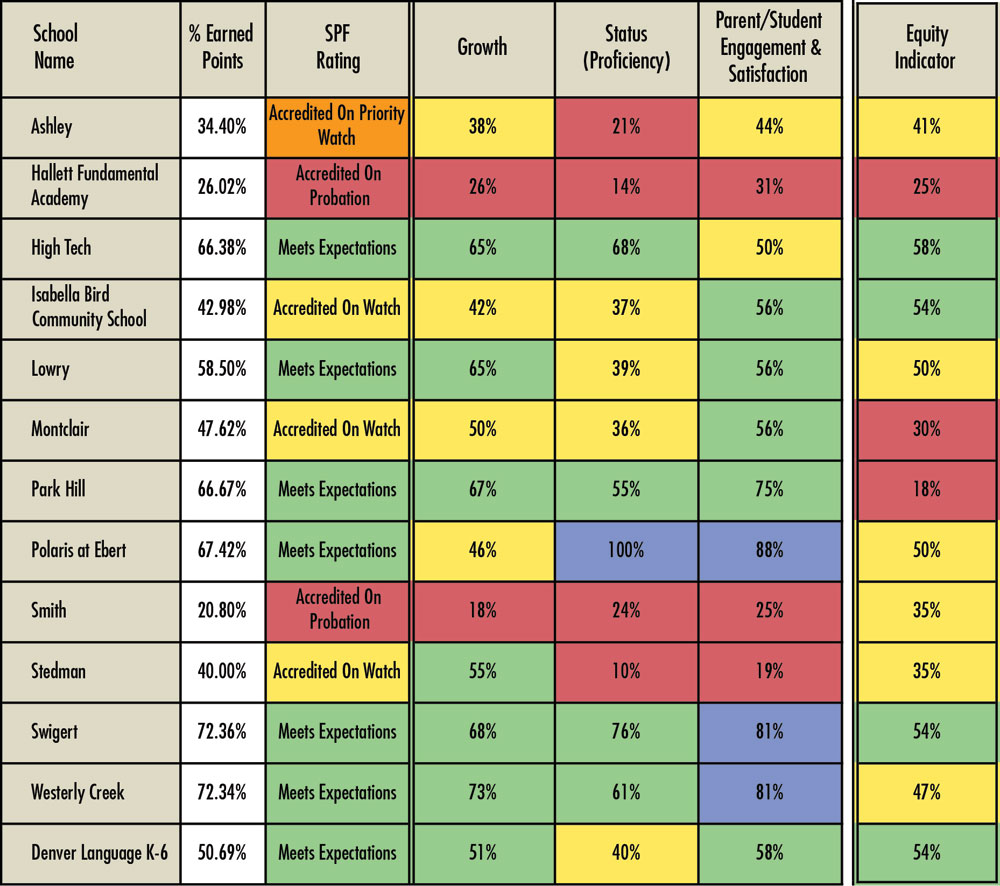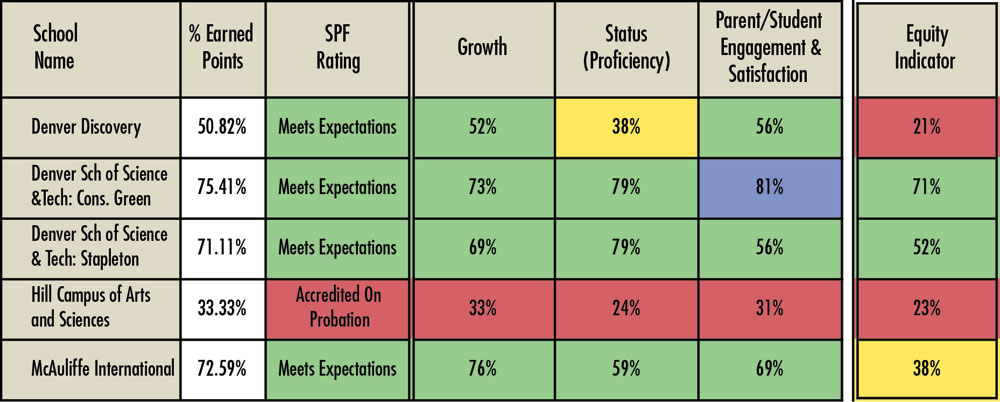
NE DENVER ELEMENTARY SCHOOLS
*Explanation of SPF Ratings
Status: Proficiency—how a school is doing at a fixed point in time.
Growth: How a school is doing over a period of time.
Parent/Student Engagement: How effectively a school connects with parents and families.
Post Secondary Readiness: How well a high school is preparing students for college and career.
Equity: How at-risk students’ growth and status compare with other students in that school and in the district.
SPF Ratings: Blue—doing very well. Green—doing well but has areas for improvement. Yellow—has quite a few areas that need improvement and receives extra support from DPS. Orange—has many areas to focus on and gets extra support from DPS. Red—performing significantly below expectations and needs significant support. The Board of Education may determine the school needs to be restarted.
————————–
School Performance Framework (SPF) “stoplight” scores are out for DPS schools, for the first time in two years, and the results are surprising to many in the local community.
The color-coded school ratings are an important tool for parents, teachers and administrators to evaluate performance and choose schools. Scores are based on test results and parent-student satisfaction surveys.

NE DENVER K-8

NE DENVER MIDDLE SCHOOLS
—
Fewer Schools Meeting or Exceeding Standards This Year
The only Northeast Denver school to receive an overall blue (“Distinguished”) rating this year is DSST: Stapleton High School. This is a striking decrease from the seven area schools that met distinguished criteria in 2014.
Many of the Northeast Denver schools performed very well on the challenging PARCC exams, demonstrating outstanding student proficiency and growth. Based on new formulas, these achievements do not directly translate into higher overall ratings. Other factors within the status (proficiency) and growth categories of the SPF are now more heavily weighted, such as equity measures.
Equity measures include comparing groups of at-risk students to their at-risk peers districtwide and also comparing them to their non-at-risk peers at the same school. This within-school comparison is new this year, and it has dragged down scores at area schools, causing concern with principals, teachers and parents. Seven local schools with historically high performance are now threatened with losing their green (“Meets Expectations”) status next year due to these gaps among learner groups.
Growth is now three times as important as status in the SPF calculation. According to Grant Guyer, executive director of the Department of Accountability, Research and Evaluation (ARE), this reflects DPS’s “fundamental philosophical belief” in promoting growth. As a result, equity gaps in growth are now multiplied by three.

NE DENVER HIGH SCHOOLS
—
Equity Indicator
DPS is now placing student achievement gaps front and center in a way no one can ignore. Students at a school may show high proficiency and high growth on statewide tests—but if there is a wide gap between at-risk students and their high-performing peers, schools now get dinged on the newly added “equity indicator.”
At-risk groups include students living in poverty, English Language Learners (ELL), students with disabilities, and students of color.
“More affluent kids not only have higher status (proficiency) than kids of poverty, but the growth of the more affluent kids is higher than the kids in poverty, which means that schools are not only not closing gaps, but gaps are widening,” says Tom Boasberg, DPS superintendent. “… when your kids are behind there is a particular emphasis on the importance of them growing. And I think that’s what the equity indicator highlights.”
The equity measure is already built into the test-based calculation of growth and status on the SPF—the new equity category is merely a way to draw attention to those built-in factors. Those formulas are expected to remain the same next year.
To increase the impact of the equity factor next year, DPS has said that the equity indicator will override the overall SPF rating—schools must have at least a green equity rating in order to achieve an overall blue or green rating, no matter their performance in growth, status and family satisfaction.
Schools have been taken by surprise. Ken Burdette, principal of Park Hill Elementary, reports that there was little warning from DPS that the equity indicator would be used to override overall SPF ratings next year. “It’s like setting out to run a 26-mile marathon and then being told at mile 13 that you actually have to run 36 miles,” he said.
Local Impact of Equity Indicator
If DPS had applied the equity indicator as a “trump card” this year, seven Northeast Denver schools would have moved from green to yellow (“Accredited/On Watch”), including Bill Roberts, McAuliffe, Westerly Creek, and Polaris. These schools are currently in yellow (“Approaching”) status on the equity indicator, which would override their overall green rating.
Two schools, Park Hill Elementary and Denver Discovery School, appear to be particularly at risk since they are currently in red (“Does Not Meet”) status on the equity indicator, despite green status overall. Districtwide, 33 high-performing schools appear to be at risk of losing their current standing.
Local school leaders strongly support the goal of equity but are worried about these unintended consequences. According to Burdette, “Equity is incredibly important. My concern is that equal does not mean equitable.”
For example, a school where both at-risk and other students are equally underperforming will earn a higher equity score than a school like Park Hill, where both groups are considerably beating DPS averages but the at-risk students are not improving as fast as the other students.
Burdette is also concerned about staff and community morale in response to the equity indicator. “Park Hill is an amazing school, so I worry about the perception it gives my teachers, the parents, my students.”
Addressing the Gaps
Local schools will have to close the equity gaps, and do so quickly, in order to retain green status moving forward.
Some schools are not deeply concerned, such as Bill Roberts. Its middle school (when separated from the elementary) met equity goals. It was also the highest-performing middle school in the area and second-highest in the district on the SPF.
Erik Cohen, assistant principal at Roberts, says he values the SPF much more than raw PARCC scores because it shows “a very intentional, comprehensive look at the school that takes into account the importance of growth, as well as status, and parent-student satisfaction.”
But even Cohen has questions about the use of equity comparisons, “When we look at our growth, it’s only a three-point difference [between Free and Reduced Lunch (FRL) and non-FRL students]. That gap is extremely narrow, but unless the group on the bottom is accelerating higher, we’re always going to have a gap ….”
Part of the problem is that higher-income students simply have more resources than students living in poverty, which can translate to higher achievement.
Boasberg says DPS is addressing this inequality by giving more support to schools that have students from low-income families. DPS is providing professional development opportunities to teachers, increasing its social-emotional health support at schools, and also offering an “Equity Boot Camp” to educators focusing on detailed, specialized training for teaching ELL and students of color.
Burdette is sharply focused on closing the gaps with intentional instruction, but he has also forwarded his concerns about the equity indicator to his instructional superintendent and school community. He recently received a troubling, tongue-in-cheek question from a parent: “Is the surest way to close the equity gap giving high-performing students ‘a year off’ so others can catch up?” Burdette says he would never consider that.
“We’re doing a great job,” says Burdette, “… we were highest in math and third highest in English Language Arts for growth in the area.” He calls the new equity measure “an incredibly rushed indicator,” adding, “I don’t think it’s been well-vetted or well thought out.”
Author’s Observations
There is much to admire in DPS’s bold and progressive emphasis on ensuring that all students in our city are receiving equitable, high-quality education. Highlighting the issue for schools through an equity indicator makes sense—families should be aware of how our schools are teaching their most at-risk students and schools should be working, as they are, to close that gap.
However, mediocre growth that is uniform across groups is favored by the equity indicator more than higher growth that is unevenly distributed. It is unreasonable to put so much weight on the gaps between at-risk students and their more affluent peers at the same school, when both groups are generally outperforming the district and state averages. The unintended consequence is an “Accredited/On Watch” label for schools whose students—all of them—are actually learning at accelerated levels. This sends the wrong message to parents, teachers and communities.
All the boats are being lifted in the rising tide of high performance and high growth that we see at so many Northeast-area public schools. It would be a shame for “Accredited/On Watch” status conferred by equity indicators to diminish the reputation of our schools, just at a time when economic integration is improving and higher-income families are choosing to keep their kids in public schools.
To learn more about SPF ratings and find detailed reports for schools, go to http://spf.dpsk12.org/.




excellent and informative reporting on a very important issue. I agree completely with the author’s assessment. It makes no sense to give a school a higher rating because all of its students are learning at the same slow rate while giving a low rating to a school where all students are learning, although some are learning more quickly than others. Children with more in-home resources are going to advance more rapidly than children with fewer resources. Yes, let’s provide the lower income students with more help but not try to hold back the faster achieving students.